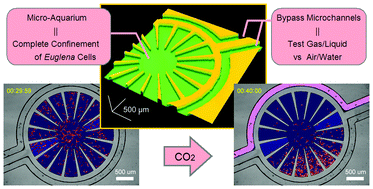Gas/liquid sensing via chemotaxis of Euglena cells confined in an isolated micro-aquarium†
Abstract
We demonstrate on-chip gas/liquid sensing by using the chemotaxis of live bacteria (Euglena gracilis) confined in an isolated micro-aquarium, and gas/liquid permeation through porous polydimethylsiloxane (PDMS). The sensing chip consisted of one closed micro-aquarium and two separated bypass microchannels along the perimeter of the micro-aquarium. Test gas/liquid and reference samples were introduced into the two individual microchannels separately, and the gas/liquid permeated through the PDMS walls and dissolved in the micro-aquarium water, resulting in a chemical concentration gradient in the micro-aquarium. By employing the closed micro-aquarium isolated from sample flows, we succeeded in measuring the chemotaxis of Euglena for a gas substance quantitatively, which cannot be achieved with the conventional flow-type or hydro-gel-type microfluidic devices. We found positive (negative) chemotaxis for CO2 concentrations below (above) 15%, with 64 ppm as the minimum concentration affecting the cells. We also observed chemotaxis for


 Please wait while we load your content...
Please wait while we load your content...